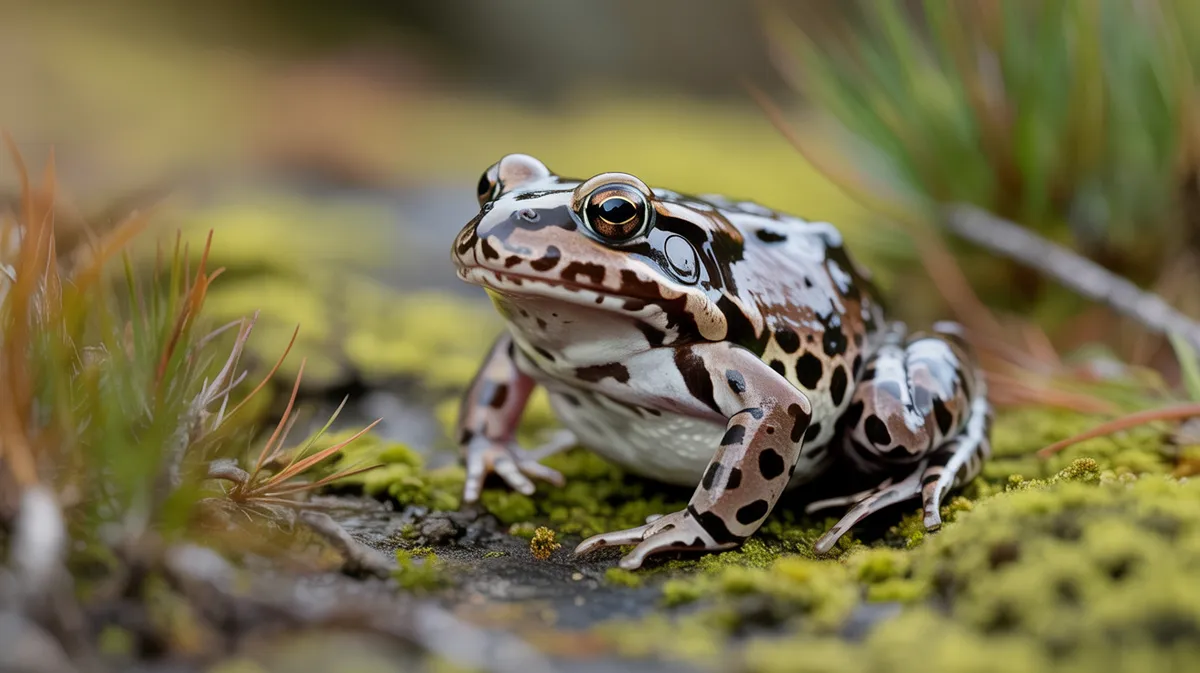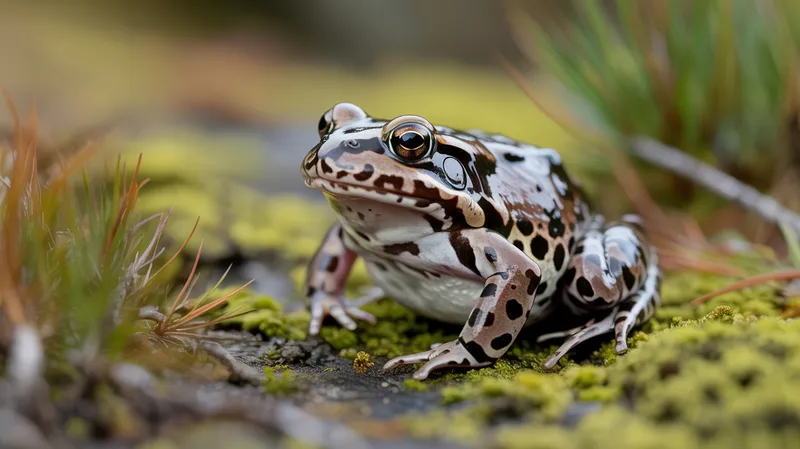
Black rain frog
Breviceps fuscus

Meet the Black rain frog
The black rain frog is a small, stout amphibian native to the southern coast of South Africa. Recognized for its dark, almost black coloration and grumpy appearance, this frog is adapted to a subterranean lifestyle in forested and mountainous regions. It is a terrestrial species that rarely enters water, preferring to burrow in moist soil to avoid desiccation. The black rain frog is well known for its defensive posture, inflating its body to appear larger when threatened.
Classification
Amphibian
Habitat
Mountain forests and heathland
Diet
Insectivore
Lifespan
4-15 years
Conservation
Least Concern
Weight
4-5 grams
📖Fascinating Facts
Rainy Home
The black rain frog is endemic to the southern slopes of South Africa's Cape Fold Mountains, where heavy rainfall creates its preferred moist environment.
Insect Eater
Its diet consists mainly of ants, termites, beetles, and other small invertebrates found in the leaf litter and soil.
Permanent Frown
This species is famous for its 'grumpy' facial expression, caused by a naturally downturned mouth.
📋Detailed Description
The black rain frog (Breviceps fuscus) is a robust, terrestrial amphibian measuring 40–51 mm in snout-vent length, with females generally larger than males. Its body is rounded and compact, with short limbs and a blunt, short snout, giving it a distinctive, almost spherical appearance. The skin is granular and dark brown to nearly black, aiding in camouflage among leaf litter and soil. Unlike most frogs, B. fuscus lacks webbing between its toes and fingers, reflecting its adaptation to a fossorial (burrowing) lifestyle. The eyes are relatively small and positioned dorsally, while the tympanum (external ear) is not visible. This species is rarely seen above ground except during wet weather or at night, as it spends most of its life in self-excavated burrows up to 15 cm deep. When threatened, it can inflate its body, making itself appear larger and more difficult for predators to extract from its burrow. The black rain frog is primarily nocturnal, emerging at dusk to forage. Its vocalizations are low-pitched and seldom heard, as males call from within their burrows during the breeding season. This species is endemic to the southern coastal regions of South Africa, particularly in the fynbos and forested slopes of the Tsitsikamma Mountains.
💡 Did you know?
The black rain frog can emit a high-pitched squeak when handled, which is unusual among frogs of its size.
🔬Research & Sources
Wikipedia Summary
Breviceps fuscus, also known as black rain frog, plain rain frog, brown short-headed frog, and Tsitsikamma rainfrog, is a species of frogs in the family Brevicipitidae. It is endemic to the southern coast of South Africa.
Last Modified: 5/2/2025
🎭Behavior & Social Structure
Breviceps fuscus is a solitary and highly secretive species, spending most of its time underground in moist, sandy soils. It is primarily nocturnal, emerging at night to hunt for small invertebrates such as ants, termites, beetles, and other soil-dwelling arthropods. The frog uses its strong, muscular hind limbs and specialized spade-like inner metatarsal tubercles to dig backward into the substrate, creating burrows for shelter and breeding. Social interactions are limited outside the breeding season, with individuals maintaining exclusive burrows. During the breeding season, males emit a soft, low-frequency call from within their burrows to attract females. Defensive behaviors include body inflation and a tight, wedged posture within the burrow, making extraction by predators or researchers difficult. The species is not known to form aggregations or exhibit complex social structures.
👶Reproduction & Life Cycle
Breviceps fuscus exhibits direct development, a reproductive strategy in which eggs develop into miniature froglets without a free-living tadpole stage. Breeding typically coincides with the rainy season (May to September), when soil moisture is optimal. Males call from within their burrows to attract females. Upon selection, the female enters the male's burrow, where amplexus (mating embrace) occurs. The female lays a clutch of 20–40 large, yolk-rich eggs in a subterranean chamber. Both parents may remain in the burrow during egg development, with the male sometimes assisting in guarding the eggs. Incubation lasts 6–8 weeks, after which fully formed froglets emerge. This reproductive strategy minimizes predation risk and dependency on standing water, a key adaptation to their terrestrial environment.
🛡️Adaptations & Survival
The black rain frog has evolved several adaptations for a fossorial lifestyle. Its stout, muscular body and short limbs facilitate efficient burrowing. The absence of webbing and the presence of a hardened, spade-like tubercle on the hind feet aid in digging. Its granular, dark skin provides camouflage and reduces water loss. The species can absorb moisture directly through the skin, allowing survival in relatively dry conditions. Behavioral adaptations include nocturnality to avoid daytime desiccation and predation, and the ability to inflate the body as a defense mechanism. Direct development eliminates the need for aquatic habitats for reproduction, allowing colonization of upland and forested areas.
📚Research Sources
🎨Cultural Significance
The black rain frog has gained international attention in recent years due to its unique appearance and 'grumpy' facial expression, making it a popular subject in internet culture and social media. However, there is little evidence of traditional uses or significant roles in local folklore among indigenous South African communities. Its presence in the fynbos biome, a global biodiversity hotspot, underscores its ecological importance as an indicator species for soil health and ecosystem integrity.
🔬Recent Research & Discoveries
Recent research has focused on the phylogenetics and biogeography of the Brevicipitidae family, revealing deep genetic divergence among populations of B. fuscus and related species. Studies on its reproductive biology have highlighted the evolutionary significance of direct development in amphibians. Ongoing ecological monitoring in the Tsitsikamma region is assessing the impacts of habitat fragmentation and climate change on population viability. There is also interest in the species' skin secretions, which may possess antimicrobial properties, a common trait among amphibians.
🎥Wildlife Videos

Amazing Rain Frogs | Life In Cold Blood | BBC
Welcome to BBC Studios, bringing you the best of British TV! Here you'll find classic comedy, gripping drama, as well as the best ...
BBC Studios

The Secrets Of The Frog | Our World
Most people perceive frogs as cold, wet, slimy, ugly creatures that give us warts on the slightest contact. The closer we look at ...
Our World

Tiny Frog Faces Night Full Of Terrors | Eden: Untamed Planet | BBC Earth
#Eden Watch more: Planet Earth http://bit.ly/PlanetEarthPlaylist Blue Planet http://bit.ly/BluePlanetPlaylist Planet Earth II ...
BBC Earth

LIFE CHARACTER OF THE "BLACK RAIN FROG" #rainfrog #blackrainfog #EcoExplorerVibes
LIFE CHARACTER OF THE "BLACK RAIN FROG" Title: "Unveiling the Charms of the Black Rain Frog: Conservation Chronicles ...
EcoExplorerVibes

Rain Frog 🐸 The Avocado Frog!
Ever heard of the Rain Frog? These tiny amphibians are masters of mystery, emerging from the depths of tropical rainforests ...
Furry Pets TV

The Rain Frog
This is a video of the rain frog from the BBC's Life in Cold Blood documentary series.
globalzoo
🌍Habitat Information
The Black rain frog typically inhabits Mountain forests and heathland environments. Black rain frogs have adapted to their environments with specialized features and behaviors.
Primary Habitat:
Mountain forests and heathland
More detailed habitat information will be available soon.
🛡️Conservation Status
The Black rain frog is currently classified as Least Concern. Conservation efforts are crucial for preserving this species for future generations.
Common Threats:
- 🏠Habitat loss and fragmentation
- 🌡️Climate change impacts
- 🎯Hunting and poaching
- 🏭Human-wildlife conflict
⚠️Threats & Conservation Challenges
Although currently listed as Least Concern by the IUCN, Breviceps fuscus faces localized threats from habitat loss due to afforestation, agricultural expansion, and urban development along the southern Cape coast. Invasive species, such as predatory mammals and introduced plants, may alter soil structure and microhabitats. Climate change poses a long-term threat by altering rainfall patterns and increasing the frequency of droughts, potentially reducing suitable breeding sites. Despite these challenges, the species persists in several protected areas, and its cryptic, burrowing habits provide some resilience against surface disturbances.
🔬Scientific Classification
Scientific Name
Breviceps fuscus
Classification Hierarchy
🔍 About Taxonomic Classification
Taxonomic classification is a hierarchical system used by scientists to classify and organize living organisms based on shared characteristics and evolutionary relationships.
The system moves from broad categories (Kingdom) to increasingly specific ones, with each animal's scientific name typically consisting of its Genus and species.
📝Community Notes
Share your observations and insights about the Black rain frog with our community of wildlife enthusiasts.
Join Our Community
Sign in to share your observations and connect with fellow wildlife enthusiasts.
Sign In to ContributeNo community notes yet
Be the first to share your observations about the Black rain frog!
Explore Black rain frog
Select a tab above to learn more about this amazing animal.
📸Photo Gallery
No photos available for this animal yet.
🌟Discover More Wildlife
Continue your journey of discovery with more fascinating animals from our database
